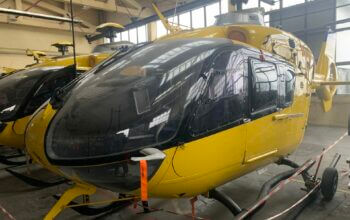Estimated reading time 7 minutes, 9 seconds.
For Canada’s two largest airports, it’s a time of multitasking in order to reduce their carbon footprints and set long-term climate goals, while still keeping their immediate focus on overcoming congestion at terminals.
Airport executives in Toronto and Vancouver say they are striving to do their part to decrease emissions of greenhouse gases (GHGs). They also acknowledge strains on their operations during the recovery in passenger traffic.
The Greater Toronto Airports Authority (GTAA) has selected three companies to guide the way toward reducing carbon emissions at Pearson International Airport (YYZ). AECOM, Alectra Energy Solutions, and Enwave Energy have been tasked with collaborating to produce a master plan for Pearson to decrease GHGs while also seeking energy efficiencies related to the operation of the two passenger terminals at Canada’s largest airport.

The GTAA said Pearson airport is “incorporating environmental considerations into all airport operations and capital projects.”
On the West Coast, the Vancouver Airport Authority said it is making steady progress in its carbon-reduction program. Vancouver International Airport (YVR) emphasized that it will remain committed to its environmental goals during the long-awaited upswing in passenger traffic, following the hard-hitting Covid-19
pandemic.
Canada’s second-largest airport said it is “focused on supporting the
decarbonization of aviation overall, in conjunction with the ongoing efforts of the federal government’s Aviation Climate Action Plan, and is working with partners to support them in reducing their emissions.”
Both Toronto Pearson and Vancouver International have faced significant challenges in 2022 as travel demand recovers.
In November, GTAA chief executive officer Deborah Flint announced an online reservation system for air travelers to book their spot for security screening up to 72 hours before departure. Under the program called YYZ Express, a QR code is sent to passengers, who must then show up at the security checkpoint within 15 minutes of their appointment time.
The aviation sector in general has struggled with logistical challenges amid labor shortages, with not enough workers in areas such as baggage handling. The Canada Border Services Agency, too, is trying to keep pace with the sharp increase in the number of air passengers during 2022.
“As we reflect on lessons learned from the pandemic and look to the future, the importance of connection has clearly illustrated the responsibility we have to lead and grow with purpose to help build a community that is resilient, thriving, and sustainable,” said YVR CEO Tamara Vrooman in a statement.
In late October, Vrooman spoke to an audience from the Greater Vancouver Board of Trade, delivering her first in-person speech since becoming YVR’s CEO in July 2020.
YVR has outlined four pathways to decrease carbon emissions within its direct operations: green fleets such as electric vehicles; energy conservation and electrification; replacing fossil fuels with renewable
alternatives, including in lighting and other electrical needs; and purchasing carbon offsets and removals when required.
Those four goals are within what’s known in climate lingo as Scope 1 and Scope 2 carbon emissions. Scope 1 emissions are those from sources owned or controlled by an entity, while Scope 2 refers to indirect emissions from the purchase of electricity, heat, or steam.

Scope 3 is the toughest category to decarbonize. In this instance, it refers to indirect emissions originating from consumer travel demand, which leads to aircraft fuel consumption instead of being within the direct control of entities such as airports.
Despite the aviation industry’s efforts to minimize its impact with long-term initiatives — such as the development of sustainable aviation fuel — environmental groups are warning about climate impacts.
“Flights are energy intensive and depend on fossil fuels,” said the David Suzuki Foundation in a statement on its website. “Fly only when necessary and stay longer.”
The Canadian Airports Council has acknowledged that more work needs to be done on the sustainability front in the years ahead.
“While air travel has continued to grow, Canada’s aviation sector is taking practical steps to limit emissions and the impact of air travel on the environment,” the council said in a statement, adding that it is encouraged by pollution mitigation strategies. “These include the comprehensive and internationally recognized Airports Council International (ACI) Airport Carbon Accreditation program, with 20 Canadian airports signed on to date, and more getting on board.”
In 2021, YVR achieved what is known as Level 4 airport carbon accreditation from ACI, and attained Level 4+ designation in 2022.
YYZ obtained the sought-after certification of Level 4 Transformation in 2022.
“Level 4 and 4+ will therefore encourage airports to reduce their emissions in line with the latest scientific and political developments, [as well as] meet growing public and stakeholder expectations,” according to ACI, which has established six different levels of carbon accreditation.








